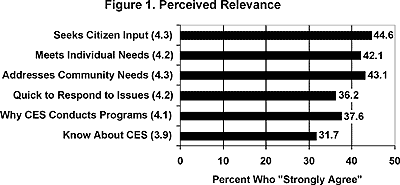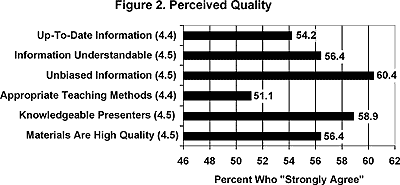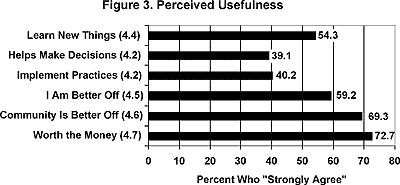April 2001 // Volume 39 // Number 2 // Research in Brief // 2RIB5
An Examination of Customer Satisfaction in the Kentucky Cooperative Extension Service
Abstract
In response to a growing trend to base funding decisions on customer satisfaction scores, the Kentucky Cooperative Extension Service commissioned a study to examine the degree to which it was meeting the needs of Kentuckians. Overall, results were very positive, with more than 90% saying that Extension was a good investment of public funds. The organization received high scores for program quality and customer service, but it scored slightly lower on relevance and usefulness. Infrequent users rated Extension to be less relevant and useful than did frequent users.
Introduction
Public institutions are operating in a new climate of accountability. Decision-makers want more than accurate ledger sheets and a summary of what was done with their appropriations. They want information that communicates worth or value of programs.
One way of producing evidence of worth or value is to measure how well an institution's programs are producing their intended outcomes. Such outcome measurement is characteristic of several results-based accountability initiatives that have been implemented recently across the nation. Without question, outcome measurement has become the predominant theme in the accountability arena for the past several years.
Now, however, more attention is being paid to customer satisfaction as funding decisions are made. Even when an agency meets its outcome-based performance goals, few taxpayers want to fund an agency if its programs are viewed as irrelevant or staff are perceived as rude or unresponsive. Hatry (1999) categorizes customer satisfaction as an outcome of program activity, but most analysts agree that, while customer satisfaction is indeed an indicator of program worth, it is not the same as an outcome that reflects the benefit to society produced by a program.
Since 1994, the University of Michigan Business School, in partnership with Arthur Anderson, and the American Society for Quality, have conducted quarterly reviews of customer satisfaction for 164 private-sector companies using the American Customer Satisfaction Index (ACSI). Much of the current emphasis on measuring public satisfaction with government services can be traced back to 1993, when President Clinton issued Executive Order 12862 (The White House, 1993) requiring "all executive departments and agencies that provide significant services directly to the public, to survey customers to determine the kind and quality of services they want and their level of satisfaction with existing services."
The desire to compare public-sector satisfaction data with data from the private sector led to the selection of the ACSI methodology being used to measure the public's satisfaction with services provided by 29 different federal agencies. Overall, the weighted satisfaction score for government was slightly less than that for the private sector, but the results were encouraging. Agencies that have considerable contact with the public received high marks for courtesy and professionalism. Information-providing agencies were found to be accessible, useful, and of high quality (University of Michigan, 1999, December 13).
In addition to the national initiative to measure customer satisfaction, several state legislatures have passed measures that require public agencies in those states to conduct periodic assessments of customer satisfaction.
Purpose of the Study
Recognizing the importance that customer satisfaction scores are likely to play in future funding decisions, a study was commissioned by the Kentucky Cooperative Extension Service to examine how well it was meeting the needs of the citizens of the Commonwealth. Although the Kentucky legislature does not require an assessment of customer satisfaction, data that document how clients view the Kentucky Cooperative Extension Service and its programs are a valuable supplement to the outcome-based accountability data the organization has been collecting for several years.
Dimensions of Customer Satisfaction
An examination of the various customer satisfaction studies that had been conducted within the Extension system revealed four key concepts that comprised the overall construct of customer satisfaction (Cummings & Ladewig, 1998; Israel & Fugate, 1998; Holmes, 1999). These were relevance, quality, usefulness, and customer service. Research questions were developed to guide inquiry for each dimension.
- Relevance: Is the Kentucky Cooperative Extension Service doing the right things? Are mechanisms for gathering local input into program direction functional?
- Quality: How well does the Kentucky Cooperative Extension Service conduct its programs? Do delivery methods and materials meet expectations?
- Usefulness: Are programs of the Kentucky Cooperative Extension Service perceived to make a difference in the lives of Kentuckians?
- Customer Service: What is the nature of the interaction between customers and Extension personnel?
These four dimensions of customer satisfaction were used as a framework for both the collection and presentation of data.
Methodology
Information was collected through a series of public meetings held in 14 Kentucky counties during the summer of 1999. Because it was unlikely that a random sample of counties would result in a truly representative sample of Kentucky's 120 counties, counties were purposefully selected to achieve maximum diversity across the state. Two of the counties represented heavily populated urban areas of the state. Four of the counties contained cities that serve as regional commerce centers. Two counties were "bedroom communities" of major metropolitan areas, while the remaining six were rural.
Extension staff from the 14 counties participated in one of three regional orientation sessions designed to help them gain a clearer understanding of their responsibilities with the study. Local staff were responsible for securing a meeting facility, inviting local citizens to participate, and welcoming those who attended. The staff were instructed to invite a representative cross-section of the county's population to the meeting, with the understanding that at least one-third of those invited would be either infrequent or non-users of Extension.
Each meeting was conducted by a team of facilitators from outside the county. Each team included a representative of Extension's Program and Staff Development Unit, an Area Program Director, an Extension specialist, and a county Extension agent. Teams used both quantitative and qualitative methods to gather data from the participants.
Upon arriving, each participant completed a 29-item questionnaire. Six of the items on the questionnaire related to relevance, six to quality, six to usefulness, and six to customer service. For these 24 questions, participants used a five-point Likert-type rating scale to indicate the degree to which they agreed with a statement provided for their reaction (1=strongly disagree; 5=strongly agree).
A single question was used to measure overall level of satisfaction with Extension programs and services. Again, a five-point Likert-type rating scale was used to measure overall satisfaction but with anchors representing levels of satisfaction (1=highly dissatisfied; 5=satisfied) rather than degrees of agreement.
The remaining four questions were used to gather data from the participants regarding frequency of Extension use, age, race, and gender.
Frequency distributions were prepared for all items. Means were calculated for all items except those used to collect demographic information. Composite means were calculated for each of the six-item sub-scales (relevance, quality, usefulness, and customer service).
After completing the questionnaires, participants discussed the same four dimensions of relevance, quality, usefulness, and customer service in facilitated focus groups. Ideas generated in the small group discussions were recorded on flip chart paper. Content analysis of comments written on flip charts during the small group meetings was used to identify key themes related to the four areas.
Results
A total of 384 individuals participated in the 14 public meetings held across the state, for an average of 27 participants per site. Fifty-seven percent of participants were female. Ninety-three percent of participants were white, and seven percent identified themselves as non-white.
Twenty-eight percent of participants described themselves as infrequent users of Extension, while the remainder classified their use as frequent. Forty percent of participants were 21 to 49 years of age, and thirty-seven percent were 50 to 64. Nineteen percent were 65 and older. Four percent were under 21.
Overall Satisfaction
Participants were highly satisfied with the programs and services of the Kentucky Cooperative Extension Service. The mean score for overall satisfaction was 4.6 on a five-point scale. A score of five corresponded to being "very satisfied." Specifically, 91.7 percent said they were either "very satisfied" or "satisfied."
Relevance
Six items on the questionnaire related to relevance of Extension programs and services. The mean score for all items related to relevance was 4.2. Although a score of 4.2 on a five-point scale represents a relatively high level of perceived relevance, the score for the relevance domain was the lowest of the four domains. Figure 1 shows both the means and the percent of individuals who responded "strongly agree" for each of the six statements related to relevance. The respondents felt that Extension does a good job of seeking citizen input, but not everyone in the community is aware of Extension programs and services. Infrequent users tended to rate the relevance of Extension programs lower than did frequent users (p<.05).

Statements recorded during the small group discussions indicated that participants felt that traditional Extension programs meet the needs of audiences they serve. But they also realized that these programs tend to serve a rather narrow segment of the population. They felt that many of those who needed Extension's help the most were not aware of what it had to offer. While some said that programs needed to be updated to reflect a more contemporary image, others said relevance could be increased by focusing on issues of wide public concern.
Quality
Six items on the questionnaire related to quality of Extension programs and services. The mean score for all items related to relevance was 4.5 on a five-point scale. Figure 2 shows both the means and the percent of individuals who responded "strongly agree" for each of the six statements related to quality. The respondents felt that information citizens receive from Extension is perceived to be unbiased and that presenters of information are knowledgeable of their subject.

Statements recorded during the small group discussions indicated that clientele place a great deal of confidence in the information they receive from Extension. They felt that educational materials they receive are of high quality and that information is easy to understand.
Usefulness
Six items on the questionnaire related to the usefulness of Extension programs and services. The mean score for all items related to usefulness was 4.5 on a five-point scale. By circling either "agree" or strongly agree" on their questionnaires, 92% of respondents felt that their community was better off because of Extension and more than 90% said that Extension is a good investment of public funds. Figure 3 shows both the means and the percent of individuals who responded "strongly agree" for each of the six statements related to usefulness. Infrequent users tended to rate the usefulness of Extension programs lower than did frequent users (p<.05).

Comments recorded in the small groups sessions also affirmed Extension's worth to the community. Participants liked the fact that Extension services were free and available to all people. However, comments by participants suggested that for Extension to be most effective it must not only deliver information, but help people use the information to make decisions. They liked having a local Extension agent help them interpret and apply information in their particular setting.
Customer Service
Six items on the questionnaire related to customer service. The mean score for the items related to customer service was 4.7 on a five-point scale. The mean score for customer service was the highest of the four domains. Figure 4 shows both the means and the percent of individuals who responded "strongly agree" for each of the six statements related to customer service. Extension received high scores for the way Extension staff interact with clientele, with 96.3% saying they either agree or strongly agree with the statement that "Extension staff are friendly and courteous."

Comments recorded during the small group discussions also suggested that Extension staff are friendly and courteous. Participants truly valued the dedication and commitment of their local Extension agents. They felt that Extension agents "go the extra mile" to serve customers.
Although customer service was an area where Extension excelled, participants in the meetings did have some suggestions for improvement. For instance, they suggested that Extension should take a serious look at office hours and adjust them to meet the needs of working customers. Others suggestions included using the Internet to disseminate information to customers. However, participants were not willing to give up the personalized service and access to agents afforded by having an Extension Office in each county.
Recommendations
Based on the data collected through both the questionnaires and small group discussions, the following recommendations were developed.
Continue to Emphasize Local Program Development
Participants in the public meetings linked Extension's success to its grass-roots program development process. This process enables Extension staff to build strong ties to the people and thus be cognizant of their needs. If Extension is to remain relevant, it must continue to employ program development processes that focus on the identification of local issues and needs.
Explore New Options for Program Delivery
In Extension, one size does not fit all. Some users of Extension value written materials that they can take home and study. Others prefer one-on-one consultation with a staff member. Still others value the interaction that occurs in group settings. For Extension to remain successful, it must continue to recognize the diversity that exists among potential clients and use a variety of program delivery methods.
Build on a History of Success
People know about and place a high value on traditional Extension programs delivered through 4-H, Extension Homemaker clubs, and on-farm technical consultation. And participants in these traditional programs are among the most satisfied with the service they receive. As a mainstay of the organization's programming for many years, they are seen as being a vital part of Extension's future, as well. But Extension must continually examine existing programs to make sure they are relevant to today's society. New programs will be needed to address emerging contemporary issues.
Capitalize on a Reputation for Objectivity
Because of its linkage to the land-grant university system, information clients receive from Extension is seen as being credible, accurate, and unbiased. As a result, Extension is viewed as impartial and objective. As society enters the information age, citizens will have an increased need for agencies and organizations that can help them navigate endless streams of data. Extension should capitalize on its reputation for objectivity and focus on helping people make decisions using the information available to them.
Maintain Friendly and Courteous Service
Ninety-six percent of those surveyed said they receive friendly and courteous service from the staff of the Cooperative Extension Service. Comments recorded during the small group discussions supported the high quantitative assessment. In the words of one user, "Extension isn't your typical government agency. No questions are viewed as trivial or insignificant, answers are provided in a timely manner, and people are treated with dignity and respect." Extension must maintain this customer-centered approach to doing business.
Increase Awareness of Extension
Participants in the meetings suggested that far too many people are still unaware of the programs and services of the Cooperative Extension Service. Some lamented the fact that many of the people who could benefit most from what Extension has to offer were not aware of the service. Some participants suggested that Extension expand the use of newspaper, radio, and television to increase overall awareness of the Cooperative Extension Service as a whole. Others cited a need to better publicize individual programs that are offered.
Reach Out to New Audiences
Participants in the small group discussions communicated a strong need for Extension to actively reach out to new audiences. Some suggested that this could be done by aggressively taking existing programs to locations where underserved audiences live and work. Others, however, suggested that many programs need to be redesigned to make them more appealing to new audiences. Some suggested that office hours need to be adjusted to accommodate today's lifestyles.
Use Technology to Meet Customer Needs
A major concern of many individuals was what they perceived to be a lack of organizational presence on the World Wide Web. Most frequently mentioned were failure to use the Internet to deliver information to the public and a lack of maintenance of county web sites. While technology was seen as a way to enhance program delivery, participants were adamant about retention of the personal service they receive from their local county Extension office. They felt that having a local professional in the county to help them interpret and apply information was essential.
References
Cummings, S. R., & Ladewig, H. (1998). Measuring customer satisfaction: How to get the most of Extension programs. Unpublished Paper. College Station: Texas A&M University Agricultural Extension Service.
Hatry, H. P. (1999). Performance measurement: Getting results. Washington, DC: The Urban Institute Press. 23.
Holmes, D. L. (1999). What our Customers are saying about us [On-line]. Logan, UT: Utah State University Extension. Retrieved March 10, 2000 at: http://www.ext.us u/evaluate/surve99.index.htm
Israel, G.D., & Fugate, A.M. (1998). Extension helps residents: Customer satisfaction high [On-line].. Fact Sheet PDE-98-05. Program Development and Evaluation Center, Florida Cooperative Extension Service. Retrieved April 9, 1998 at: http://www.ifas. ufl.edu/~peodweb/wx00900.htm
University of Michigan (1999, December 13). ACSI commentary, special report on government services [On-line]. Ann Arbor, MI: Author. Available: http://www .bus.umich.edu/research/nqrc/govt-key.html
The White House (1993, September 11) Executive Order 12862: Setting customer service standards [On-line]. Washington, DC: Author. Retrieved March 21, 2000 at: http://www.n pr.gov/library/direct/orders/2222.html
